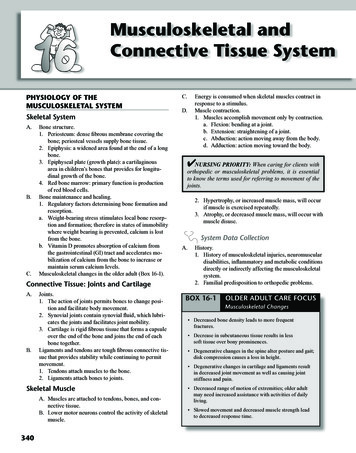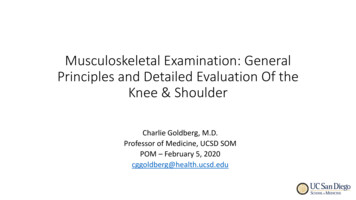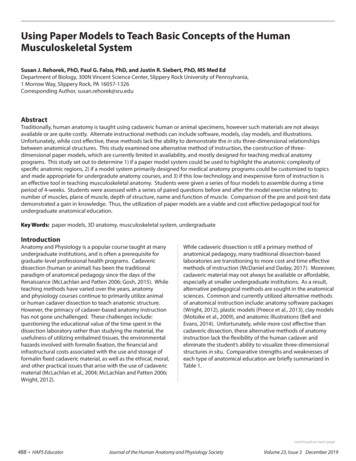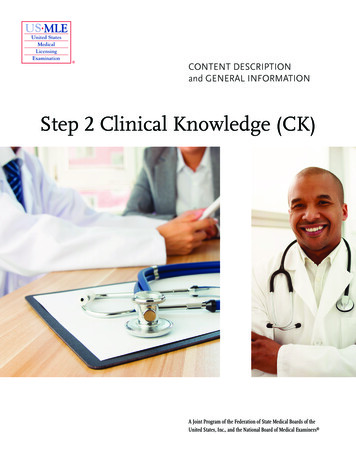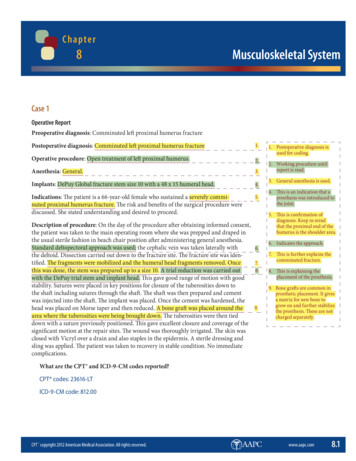
Transcription
Chapter8Musculoskeletal SystemCase 1Operative ReportPreoperative diagnosis: Comminuted left proximal humerus fracturePostoperative diagnosis: Comminuted left proximal humerus fracture1.Operative procedure: Open treatment of left proximal humerus.2.Anesthesia: General.3.Implants: DePuy Global fracture stem size 10 with a 48 x 15 humeral head.4.Indications: The patient is a 66-year-old female who sustained a severely comminuted proximal humerus fracture. The risk and benefits of the surgical procedure werediscussed. She stated understanding and desired to proceed.5.Description of procedure: On the day of the procedure after obtaining informed consent,the patient was taken to the main operating room where she was prepped and draped inthe usual sterile fashion in beach chair position after administering general anesthesia.Standard deltopectoral approach was used; the cephalic vein was taken laterally withthe deltoid. Dissection carried out down to the fracture site. The fracture site was identified. The fragments were mobilized and the humeral head fragments removed. Oncethis was done, the stem was prepared up to a size 10. A trial reduction was carried outwith the DePuy trial stem and implant head. This gave good range of motion with goodstability. Sutures were placed in key positions for closure of the tuberosities down tothe shaft including sutures through the shaft. The shaft was then prepared and cementwas injected into the shaft. The implant was placed. Once the cement was hardened, thehead was placed on Morse taper and then reduced. A bone graft was placed around thearea where the tuberosities were being brought down. The tuberosities were then tieddown with a suture previously positioned. This gave excellent closure and coverage of thesignificant motion at the repair sites. The wound was thoroughly irrigated. The skin wasclosed with Vicryl over a drain and also staples in the epidermis. A sterile dressing andsling was applied. The patient was taken to recovery in stable condition. No immediatecomplications.1. Postoperative diagnosis isused for coding.2. Working procedure untilreport is read.3. General anesthesia is used.4. This is an indication that aprosthesis was introduced tothe joint.5. This is confirmation ofdiagnosis. Keep in mindthat the proximal end of thehumerus is the shoulder area.6.7.8.9.6. Indicates the approach.7. This is further explains thecomminuted fracture.8. This is explaining theplacement of the prosthesis.9. Bone grafts are common inprosthetic placement. It givesa matrix for new bone togrow on and further stabilizethe prosthesis. These are notcharged separately.What are the CPT and ICD-9-CM codes reported?CPT codes: 23616-LTICD-9-CM code: 812.00CPT copyright 2012 American Medical Association. All rights reserved.www.aapc.com8.1
Musculoskeletal SystemChapter 8RATIONALE: CPT code: In the CPT Index, look for Fracture/Humerus/OpenTreatment and you are directed to code range 23615–23616. A humeral prosthetictreatment is performed to repair the fracture which is reported with 23616. ModifierLT should be appended to indicate it is the left humerus.ICD-9-CM code: The diagnosis is listed as a comminuted left proximal humerus fracture. In the ICD-9-CM Index to Diseases, look for Fracture/humerus/proximal whichdirects you to Fracture/humerus/upper end. There is no mention of this being anopen fracture, so default coding is closed. Verification of code 812.00 in the TabularList confirms it is used for a fracture of the proximal end of the humerus.8.22013 Medical Coding Training: CPC Practical Application Workbook—InstructorCPT copyright 2012 American Medical Association. All rights reserved.
Chapter 8Musculoskeletal SystemCase 2Preoperative diagnosis: Painful L2 vertebral compression fracture.Postoperative diagnosis: Painful L2 vertebral compression fracture.1.Name of operation: L2 kyphoplasty.2.Findings preoperatively:She had compression fractures at T 11 and L1, which underwent kyphoplasty and she3.initially had very good results, but then developed back pain once again. Repeat MRI acouple of weeks later showed that she had fresh high intensity signal changes in the bodyof L2 and some scalping of the superior end plate consistent with a compression fractureat L2. After some preoperative discussion and some patience to see if she would get better,she was admitted to the hospital for L2 kyphoplasty when she was not getting better. Atsurgery, L2 had some scalloping of the superior end plate. Most of the softness was in theback part of the vertebral body.Procedure:The patient was taken to the operating room and placed under general endotracheal anes- 4.thesia in a supine position. She was placed prone on the Jackson table and her back wasprepped and draped in the usual sterile fashion. Using biplane image intensifiers, the skin 5.incision sites were marked out. 0.5 Marcaine with epinephrine was injected. Initially onthe left side, a Xyphon trocar was passed down to the superior lateral edge of the pedicleand then passed down through the pedicle and into the vertebral body—uneventfully inthe usual fashion. The drill was then placed into the vertebral body and then the Kyphon 6.bone tamp. In a similar fashion, the same thing was done on the other side. Balloons werethen inflated uneventfully. The balloons were then deflated and removed and the cementwhen it was in the doughy state was then injected into the 2 sides in the usual fashion.This was done carefully and sequentially to make sure that there were no cement extrusions and in fact there were none, there was a good fill to the edges of vertebral body uptowards the superior end plate and across the midline. The bone filling devices were thenremoved and the trocars removed. Pressure was applied after which the skin was suturedwith 4-0 nylon. Band-Aids were applied and she was taken to recovery in stable condition.1. Postoperative diagnosis isused for coding.2. Working procedure.3. Confirmation of diagnosis.4. General anesthesia was used.5. This is describing theapproach to the defect. It ispercutaneous using trocars.6. This is describing how thearea is prepped to be enlargedand receive the cement thatis placed in a kyphoplastyprocedure.Complications: There were no complications.Blood loss: Minimal blood loss.Counts: Sponge and needle counts were correct.What are the CPT and ICD-9-CM codes reported?CPT code: 22524ICD-9-CM code: 733.13CPT copyright 2012 American Medical Association. All rights reserved.www.aapc.com8.3
Musculoskeletal SystemChapter 8RATIONALE: CPT code: In the CPT Index, look for kyphoplasty and you are directedto the range of codes 22523–22525. The code selection is based on location. 22524is the correct code for the lumbar spine. If the provider performed and documentedradiologic supervision and interpretation, you would also report 77291 or 77292. It isnot appropriate in this case because it was not documented.ICD-9-CM code: In the ICD-9-CM Index to Diseases, look for fracture/vertebra/compression and you are directed to 733.13. Verification in the Tabular List confirms733.13 is for a pathologic fracture of the vertebra. Compression fractures are considered pathological in nature; if there have been no visible injuries. If the pathologicalreason has been identified, such as osteoporosis, then that becomes the additionalcode. Our report does not mention that however, so the only code reported is733.13.8.42013 Medical Coding Training: CPC Practical Application Workbook—InstructorCPT copyright 2012 American Medical Association. All rights reserved.
Chapter 8Musculoskeletal SystemCase 3Preoperative diagnosis: Comminuted intraarticular distal radial Colles’ fracture left wrist.Postoperative diagnosis: Comminuted intraarticular distal radial Colles’ fracture left wrist. 1.Procedure: Application uniplane external fixation and closed reduction of left distalradial fracture under fluoroscopy.2.Anesthesia: General endotracheal.3.1. Postoperative diagnosis isused for coding.2. This will assist in coding theprocedure.Description of the procedure:After induction of adequate general endotracheal anesthesia, the patient’s left upperextremity was routinely prepped and draped into a sterile field. The extremity waselevated and exsanguinated with an Esmarch bandage. The tourniquet was inflated to 300millimeters of mercury. We first placed two half pins distally over the dorsoradial aspect 4.of the second metacarpal first placing first pin in freehand technique making an incision, spreading with hemostat, and then placing the half pin. The second pin was placedidentically by using the pin guide. Similarly, we placed pins in the dorsoradial aspect ofthe distal third of the radius. We then connected these 2 pins with clamps and then under 5.C-arm control we reduced the fracture. All pins are now attached to the external fixation.This fracture at both dorsal and volar comminution and intraarticular fractures and was 6.significantly shortened and telescoped. We obtained the best reduction possible and thentightened down the clamps to the bars. The pin tracks were dressed with Xeroform and2 x 2 gauze and volar 3 x 15 plaster splints were applied. The tourniquet was allowed todeflate during application of the dressing. Total tourniquet time was 14 minutes. Therewere no intraoperative complications.3. General anesthesia used.4. External fixation.5. Closed reduction underfluoroscopy.6. Comminuted aspect.What are the CPT and ICD-9-CM codes reported?CPT codes: 25605-LT, 20690-51-LTICD-9-CM code: 813.41RATIONALE: CPT codes: This is a repair of a Colles’ fracture. Looking in the indexunder Fracture/radius/Colles and you are directed to code range 25600–25605. Code25605 is correct because a reduction (manipulation) was performed. The codesfor Colles’ fracture repair (25600–25605), do not include the external fixation. Lookin the index for External Fixation/application and you are referred to code range20690–20692. The codes are differentiated by the type of fixation. In this case, it wasuniplane fixation, making 20690 the correct code to report. Modifier LT should beappended to indicate it is the left wrist. Fluoroscopy is included in the procedure.ICD-9-CM code: Look in the ICD-9-CM Index to Diseases for fracture/Colles’. You aredirected to ICD-9-CM code 813.41. Verification in the Tabular List verifies 813.41 is fora Colles’ fracture.CPT copyright 2012 American Medical Association. All rights reserved.www.aapc.com8.5
Musculoskeletal SystemChapter 8Case 4Operative reportPreoperative diagnosis: Dislocation of right elbow.1. Postoperative diagnosis isused for coding.1.Postoperative diagnosis: Dislocation of right elbow with medial epicondyle fracture.2.Operative procedure: Closed reduction of elbow dislocation with a closed reduction ofmedial epicondyle fracture.3.Anesthesia: General.4.Indications: This is a 12-year-old male who sustained a dislocation of his right elbow. Therisks and benefits of surgical treatment were discussed with the family who stated understanding and desired to proceed.2. Working procedure.3. General anesthesia used.4. Backs up diagnosis.5. This indicates a closedmethod of reduction. Thereis no indication the skin wascut.6. Indicates fluoroscopy.7. Manipulation of the medialepicondyle.8. This is showing the fracture,reduced and set. Noindication that the skin wasbroken.Description of procedure: On the day of procedure after obtaining informed consent,the patient was taken to the main Operating Room where general anesthia was induced.5. Once he was under adequate anesthesia the reduction maneuver was performed. Theelbow was reduced and was stable. Through a full range of motion there was noted to bea slight crepitus on the medial elbow and it was felt some mobility in the medial epicon6. dyle. Examination under C-arm imagery revealed a concentric reduction of the elbowbut with mildly unstable medial epicondyle. When the elbow was held in the appropriate 8.7. position the medial epicondyle was well reduced in acceptable position and it was elevetedto treat this non-surgically and therefore a long arm splint was applied. The patient wasawakened from anesthesia and taken to Recovery in stable condition with no immediatecomplications.What are the CPT and ICD-9-CM codes reported?CPT codes: 24565-RT, 24605-51-RTICD-9-CM codes: 812.43, 832.00RATIONALE: CPT codes: Look in the CPT Index for Fracture/Humerus/Epicondyle/Closed treatment and you are directed to code range 24560–24565. The code selection is based on whether manipulation is used. 24565 is the correct code for therepair of the epicondyle fracture.The first procedure performed is the reduction of the dislocated elbow. Look in theCPT Index for Dislocation/Elbow and you are directed to 24605–24615 and 24640.24640 is for nursemaid’s elbow. The code selection between codes 24605–24615is based on whether anesthesia is used. In this case, general anesthesia was used,making 24605 the correct code choice. Typically the reduction of a dislocationwould be included in the fracture repair. Modifier 51 is appended to show more thanone procedure is performed. Modifier RT would also be used to indicate it was onthe right elbow.ICD-9-CM codes: The diagnosis is stated as dislocation of right elbow with medialepicondyle fracture. The fracture is a more severe diagnosis, so it will be coded first.The medial epicondyle is the bony protrusion on the inside of your elbow and is part8.62013 Medical Coding Training: CPC Practical Application Workbook—InstructorCPT copyright 2012 American Medical Association. All rights reserved.
Chapter 8Musculoskeletal Systemof the distal end of the humerus. Look in the ICD-9-CM Index for Fracture/humerus/condyle(s)/medial (internal epicondyle) and you are directed to 812.43. For the dislocation of the elbow, look in the index for Dislocation/elbow and you are directed to832.00. Verification in the Tabular List confirms this diagnosis selection.CPT copyright 2012 American Medical Association. All rights reserved.www.aapc.com8.7
Musculoskeletal SystemChapter 8Case 5Preoperative diagnosis: Right long finger trigger fingerLeft shoulder impingement/subacromial bursitis.1. Postoperative diagnosis isused for coding.1.Postoperative diagnosis: Right long finger trigger finger.Left shoulder impingement/subacromial bursitis.Procedures: Right long finger trigger release.Injection of the left shoulder with Xylocaine, Marcaine, andCelestone via anterior subacromial approach.2. General anesthesia used.3. Shoulder injection.2.Anesthesia: General.4. The A1 pulley is a flexortendon pulley.Complications: None.5. The release of the nerve.Estimated blood loss: Minimal.Replacement: Crystalloids.Descripton of procedure: The patient was taken to the operating room where he wasgiven appropriate anesthesia. The right upper extremity was prepped and draped in theusual sterile fashion. While the draping was going on, the left shoulder was prepped withBetadine and using Xylocaine. Marcaine and Celestone, through an anterior subacromialapproach; the left shoulder was injected with 1 cc of Xylocaine, 1 cc of Celestone and 1 cc3. of Marcaine. The patient tolerated the procedure well.Meanwhile, the right hand had been prepped and draped. It was exsanguinated withEsmarch and tourniquet inflated to 250 millimeters of mercury. I made an incision over4. the A1 pulley in the distal transverse palmar crease, about an inch in length. This wastaken through skin and subcutaneous tissue. The Al pulley was identified and released5. in its entirety. Care was taken to avoid injury to the neurovascular bundle. The woundwas irrigated with antibiotic saline solution. The subcutaneous tissue was injected withMarcaine without epinephrine. The skin was closed with 4-0 Ethilon suture. Cleandressing was applied. The patient was awakened and taken to the recovery room in stablecondition.What are the CPT and ICD-9-CM codes reported?CPT codes: 26055-F6, 20610-51-LTICD-9-CM codes: 727.03, 726.19RATIONALE: CPT codes: The most complicated procedure is the right long fingertrigger release. Look in the CPT Index for trigger finger repair and you are directedto 26055. Reading the descriptor, we see tendon sheath incision, (eg, Trigger finger).For the shoulder injection, look in the CPT Index for injection/joint, you are directedto code range 20600-20610. The code selection is based on the joint. The shoulderis considered a major joint making 20610 the correct code. Modifier 51 should beappended to indicate multiple procedures. An F6 should be appended to the triggerfinger release and an LT should be appended to the shoulder injection. The proce-8.82013 Medical Coding Training: CPC Practical Application Workbook—InstructorCPT copyright 2012 American Medical Association. All rights reserved.
Chapter 8Musculoskeletal Systemdures were performed under general anesthesia which is an indication this case wasperformed in a facility. The drugs are reported by the facility-not the physician.ICD-9-CM codes: The diagnoses were stated as right long finger trigger finger andleft shoulder impingement/subacromial bursitis. For the trigger finger, look in theICD-9-CM Index for trigger finger and you are directed to 727.03 as the default (thereis no mention of it being congenital). For the shoulder, look for bursitis/subacromialand you are directed to 726.19. There is no index for impingement of the shoulder.In the Tabular List, both codes are verified. Bursitis can be a cause of shoulderimpingement (or rub).CPT copyright 2012 American Medical Association. All rights reserved.www.aapc.com8.9
Musculoskeletal SystemChapter 8Case 6Preoperative diagnosis: Painful hardware left foot.1. Postoperative diagnosis isused for coding.1.Postoperative diagnosis: Painful hardware left foot.2.Procedure performed: Removal of hardware, left foot2. Stated procedure.Anesthesia: Sedation and local3. Confirmation of diagnosis.Drain: None.Estimated blood loss: Minimal.4. Removal of hardware.3.Indications for procedure:The patient had the above-mentioned problems, unresponsive to conservative treatment.We discussed the above-mentioned surgery, along with the potential risks and complications, and the patient understood and wished to proceed.Description of procedure:With the patient supine on the operating table after the successful induction of anesthesia,the left foot was prepped and draped in the usual sterile fashion, and then I injected 0.5%Marcaine into the area of the screw heads, both on the lateral side of the foot and thendorsal midfoot, about 5 mL each area. A small incision through the skin 0.5 cm, and blunt4. dissection down to the screw head. The screw was removed with the screwdrivers. Theywere irrigated and closed with simple 4-0 nylon sutures. A sterile compression dressingwas applied. The patient was taken to the recovery room in satisfactory condition.Material sent to laboratory: None.Complications: None.Condition on discharge: Satisfactory.Discharge diagnosis: Painful hardware, left foot.Discharge plan:Discharge instructions were discussed with the patient. A copy of the instructions wasgiven to the patient and a copy retained for the medical record. The following items werediscussed: diet, activity, wound care medications if applicable, when to call the physician,and follow-up care.What are the CPT and ICD-9-CM codes reported?CPT code: 20680-LTICD-9-CM code: 996.78RATIONALE: CPT code: Look in the CPT Index for removal/implantation and youare directed to code range 20670-20680. The code selection is based on whetherthe implant (hardware) is superficial or deep. In the description of 20680, you willsee screws are considered deep. The correct code is 20680. Modifier LT should beappended to indicate it is the left foot.8.102013 Medical Coding Training: CPC Practical Application Workbook—InstructorCPT copyright 2012 American Medical Association. All rights reserved.
Chapter 8Musculoskeletal SystemICD-9-CM code: The diagnosis is stated as painful hardware, left foot. In theICD-9-CM Index, look for Complications/orthopedic device, implant, or graft orinternal (fixation) (nail) (plate) (rod) NEC 996.78. Verify the code in the Tabular List.Under subcategory 996.7, Pain due to (presence of) any device, implant, and graftclassifiable to 996.0-996.5 confirms we are in the correct subcategory.CPT copyright 2012 American Medical Association. All rights reserved.www.aapc.com8.11
Musculoskeletal SystemChapter 8Case 7Procedure performed in office.Preoperative diagnosis: Right-sided thoracic pain.1. Postoperative diagnosis isused for coding.2. Procedure perfomed.3. Three muscles injected.4. Secondary diagnosis for thevisit.5. This verifies the trigger pointsinjected.6. This is the amount and nameof of drug used.1.Postoperative diagnosis: Right-sided thoracic pain.2.3.Operation: Trigger point injection into the right-sided thoracic spine musculature, intothe rhomboid major, rhomboid minor, and levator scapular muscles.Procedure:The patient was seated on the bed. He was explained the risks, including but not limitedto bleeding, infection, nerve damage and no guarantee of symptom relief. The patient4. has metastatic lung cancer and has had a right lung resection. The patient agreed and theinformed consent was signed.I palpated for areas of maximal tenderness. Five spots were marked into the right-sidedthoracic paraspinal musculature. I then cleaned off his back with chlorhexidine x2. Thena 25 gauge 1.5 inch needle on a 10 cc controlled syringe with Depo-Medrol, 40 mg/mL5. was used. After negative aspiration, 1 cc was injected into each point. A total of four6. points were injected. A total of 4 cc (160 mg) was used. The patient tolerated the procedure well. Band-Aids were not placed. The patient was not bleeding.We are also going to refill the patient’s pain medication. He is seeing an oncologist andis getting Percocet 7.5/500. He takes four a day. That does provide him with pain relief.We are going to dispense to him today a three week supply. We are going to dispense #84.He is to return to the office in two weeks at which time we will get a urine for follow-up.Emphasized to the patient once again that he had to bring his pills to every appointmentaccording to the opioid contract.What are the CPT and ICD-9-CM codes reported?CPT codes: 20553, J1030 x 4ICD-9-CM codes: 724.1, 197.0RATIONALE: CPT codes: In the CPT Index, look for Injection/Trigger Point(s). Undertrigger point(s) you have a selection between One or Two Muscles and Three or Moremuscles. The documentation states 3 muscles were injected, directing us to 20553.Verification of 20553 confirms the code selection. The drug used for the procedureis billable also, looking in the HCPCS Level II codebook at the drug table for DepoMedrol, we are directed to Methylprednisolone acetate, code J1030 each 40 mg. Verifying it in the tabular of the HCPCS Level II codebook, J1030 is billed with 4 units (40mg x 4 160 mg).ICD-9-CM codes: Look in the index for Pain/thoracic spine and you are directed to724.1. The patient also has metastatic lung CA. Look at the Neoplasm Table and findlung. The code in the column for Malignant/Secondary is 197.0. There is no mentionthe pain is neoplasm related, so a code from category 338 is not reported.8.122013 Medical Coding Training: CPC Practical Application Workbook—InstructorCPT copyright 2012 American Medical Association. All rights reserved.
Chapter 8Musculoskeletal SystemCase 8Operative reportPreoperative diagnosis: Plantar fasciitis left.Postoperative diagnosis: Same as preoperative diagnosis.1.Procedures: Plantar fasciotomy left heel.2.For informed consent, the more common risks, benefits, and alternatives to the procedurewere thoroughly discussed with the patient. An appropriate consent form was signed,indicating the patient understands the procedure and its possible complications.This 61-year-old male was brought to the operating room and placed on the surgicaltable in a supine position. Following anesthesia, surgical site was prepped and drapedin the normal sterile fashion. Attention was then directed to the left heel where,utilizing a 61 blade, a stab incision was made, taking care to identify and retract allvital structures. The incision was deepened to the medial band insertion of the fascia.The fascia was then incised and avulsed from the calcaneus. The surgical site was then 3.flushed with saline. 1 cc of Depo-Medrol was injected in the op site. Site was dressedwith a light compressive dressing. Excellent capillary refill to all the digits was observedwithout excessive bleeding noted.1. Postoperative diagnosis isused for coding. In this case, itis the same as the preoperativediagnosis.2. Listed procedure.3. Description of the fasciotomy.Hemostasis: noneEstimated blood loss: minimalInjectables: Agent used for local anesthesia was 5.0 cc and Marcaine 0.5% with epiPathology: No specimen sent.Dressings: Applied Bacitracin ointment. Site was dressed with a light compressivedressing.Condition: Patient tolerated procedure and anesthesia well. Vital signs stable. Vascularstatus intact to all digits. Patient recovered in the operating room.What are the CPT and ICD-9-CM codes reported?CPT code: 28008-LTICD-9-CM code: 728.71RATIONALE: CPT code: Looking in the index under fasciotomy/plantar, we are onlygiven an endoscopic approach. This was not done with an endoscope. Lookingunder fasciotomy/foot we are directed to 28008. Reading the descriptor, it is indeedan incision into the foot. Modifier LT for the designation of the foot operated on.ICD-9-CM code: In the ICD-9-CM Index, look for fasciitis/plantar and you are directedto 728.71. Verification in the Tabular List confirms this is the correct code.CPT copyright 2012 American Medical Association. All rights reserved.www.aapc.com8.13
Musculoskeletal SystemChapter 8Case 9Anesthesia: General anesthesiaPreoperative diagnosis: Left Achilles’ tendon rupture.1. Postoperative diagnosis isused for coding.1.Postoperative diagnosis: Left Achilles’ tendon rupture.2.Operation performed: Open Left Achilles’ tendon repair.2. Stated procedure.Indications: The patient is 25-year-old male who was playing basketball when he washit by another player and felt a pop in the back of his ankle approximately two monthsago. Examination reveals a positive Thompson test, but no plantar-flexion on squeezingthe calf. There is a palpable defect in the Achilles’ tendon. There is some swelling in thisregion and neurovascular examination is intact. Given these clinical findings the patientis taken to the operating room for the aforementioned procedure.3. General anesthesia used.4. Rupture of Achilles’ tendonverified.5. Repair of Achilles’s tendonwith sutures.6. Short leg cast applied.Description of procedure: Following induction of general anesthesia the patient wasplaced prone on the operating table and all bony prominences were well-padded. Thepatient received a dose of one gram of Ancef. Under tourniquet control of 250 mm Hg, alongitudinal incision was made followed by an opening up the paratenon of the Achilles’4. tendon. An obvious rupture was noted. The hematoma was evacuated and the ends werethen debrided with a Metzenbaum scissors. Using a #2 FiberWire this was placed in aBunnell type fashion in both the proximal and distal portions of the Achilles’ tendon.Another #2 Orthocord was then used and placed in a running fashion along the proximaland distal portions of the Achilles’ tendon. A total of four sutures were used. These were5. then tied together to re-approximate the tendon with no significant tension on the repair.3.A nice secure repair was noted. The ends of the repair were also further augmented witha 2-0 Vicryl suture. The wound was thoroughly irrigated with antibiotics irrigation solution. The fascial plane was closed with a 2-0 Vicryl suture followed by closing the skinwith a 2-0 in subcuticular fashion. Approximately 10 cc of 0.5% Marcaine was injectedfor postoperative pain control. A routine dressing was applied to the extremity and it was6. then placed into a short leg cast with the foot slightly plantar-flexed. In addition, the anterior aspect of the cast was then univalved. The tourniquet was deflated for a total tourniquet time of 42 minutes.The patient was then awakened in the operating room breathing spontaneously and takento the recovery room in stable condition.What are the CPT and ICD-9-CM codes reported?CPT code: 27650-LTICD-9-CM codes: 845.09, E917.0, E007.6RATIONALE: CPT code: In the CPT Index, look for Achilles Tendon/repair and youare directed to code range 27650–27654. This is a primary repair and no graft wasused. 27650 is the correct code.ICD-9-CM codes: In the ICD-9-CM Index, look for rupture/tendon/Achilles’ and youare directed to 845.09. It is coded as traumatic because the diagnosis is a result of an8.142013 Medical Coding Training: CPC Practical Application Workbook—InstructorCPT copyright 2012 American Medical Association. All rights reserved.
Chapter 8Musculoskeletal Systeminjury from the patient playing basketball. Verification in the Tabular List confirms845.09 is for a sprain or strain of other specified part of the foot. E codes are reportedto describe the circumstances. For the E code, go to the Index to External Causesof Injury and Poisoning, look for Hit, hitting/other person(s)/in sports and you aredirected to code E917.0. The second E code is under Activity/basketball directing youto code E007.6. We do not have have the location of the activity, so it is not reported.CPT copyright 2012 American Medical Association. All rights reserved.www.aapc.com8.15
Musculoskeletal SystemChapter 8Case 10Preoperative diagnosis: Right ankle triplane fracture1. Postoperative diagnosis isused for coding.1.Postoperative diagnosis: Right ankle triplane fracture2.Procedure: Open reduction and internal fixation (ORIF) righ
under Fracture/radius/Colles and you are directed to code range 25600-25605. Code 25605 is correct because a reduction (manipulation) was performed. The codes for Colles' fracture repair (25600-25605), do not include the external fixation. Look in the index for External Fixation/application and you are referred to code range 20690-20692.



